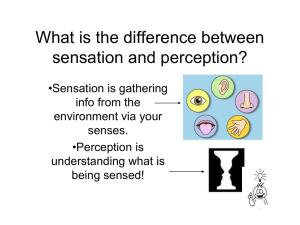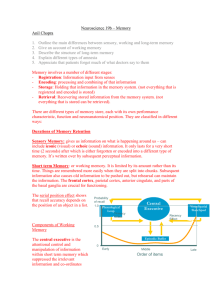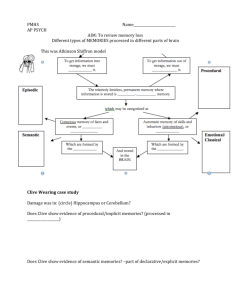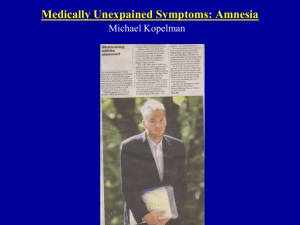Debriefing Text
advertisement
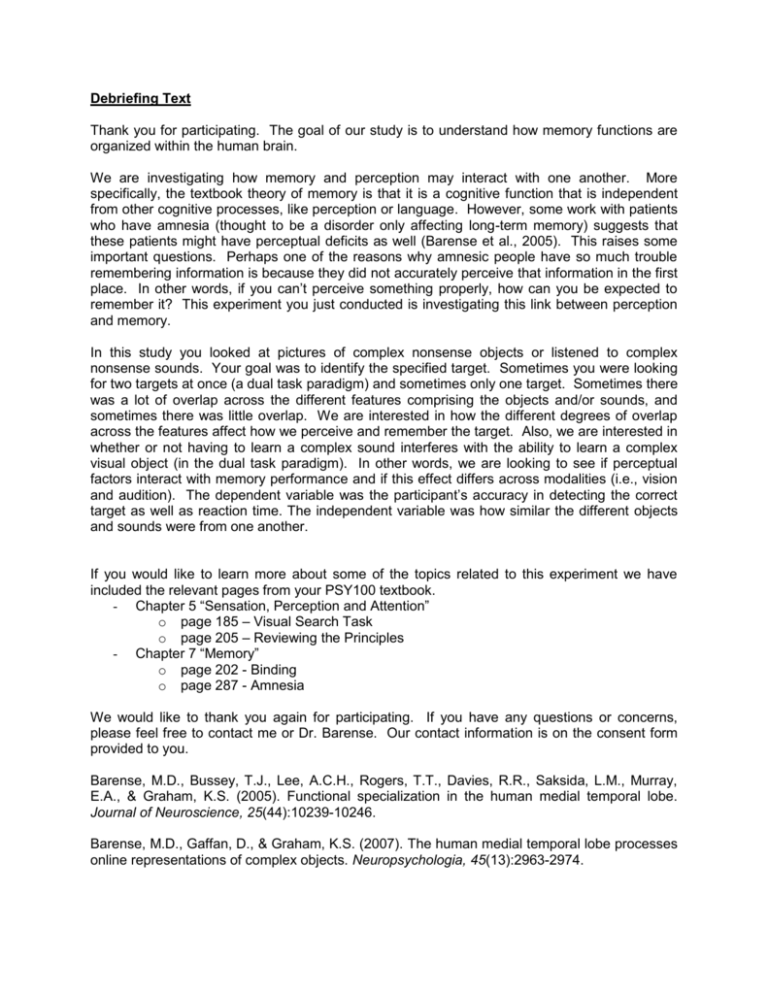
Debriefing Text Thank you for participating. The goal of our study is to understand how memory functions are organized within the human brain. We are investigating how memory and perception may interact with one another. More specifically, the textbook theory of memory is that it is a cognitive function that is independent from other cognitive processes, like perception or language. However, some work with patients who have amnesia (thought to be a disorder only affecting long-term memory) suggests that these patients might have perceptual deficits as well (Barense et al., 2005). This raises some important questions. Perhaps one of the reasons why amnesic people have so much trouble remembering information is because they did not accurately perceive that information in the first place. In other words, if you can’t perceive something properly, how can you be expected to remember it? This experiment you just conducted is investigating this link between perception and memory. In this study you looked at pictures of complex nonsense objects or listened to complex nonsense sounds. Your goal was to identify the specified target. Sometimes you were looking for two targets at once (a dual task paradigm) and sometimes only one target. Sometimes there was a lot of overlap across the different features comprising the objects and/or sounds, and sometimes there was little overlap. We are interested in how the different degrees of overlap across the features affect how we perceive and remember the target. Also, we are interested in whether or not having to learn a complex sound interferes with the ability to learn a complex visual object (in the dual task paradigm). In other words, we are looking to see if perceptual factors interact with memory performance and if this effect differs across modalities (i.e., vision and audition). The dependent variable was the participant’s accuracy in detecting the correct target as well as reaction time. The independent variable was how similar the different objects and sounds were from one another. If you would like to learn more about some of the topics related to this experiment we have included the relevant pages from your PSY100 textbook. - Chapter 5 “Sensation, Perception and Attention” o page 185 – Visual Search Task o page 205 – Reviewing the Principles - Chapter 7 “Memory” o page 202 - Binding o page 287 - Amnesia We would like to thank you again for participating. If you have any questions or concerns, please feel free to contact me or Dr. Barense. Our contact information is on the consent form provided to you. Barense, M.D., Bussey, T.J., Lee, A.C.H., Rogers, T.T., Davies, R.R., Saksida, L.M., Murray, E.A., & Graham, K.S. (2005). Functional specialization in the human medial temporal lobe. Journal of Neuroscience, 25(44):10239-10246. Barense, M.D., Gaffan, D., & Graham, K.S. (2007). The human medial temporal lobe processes online representations of complex objects. Neuropsychologia, 45(13):2963-2974. Debriefing Questions: Q: What is the purpose of this study? A: To investigate how perception and memory interact. Q: What were the independent variables? A: How similar the different fribbles and sounds were. Q: What were the dependent variables? A: Accuracy in detecting the target (and reaction time) Q: Were investigating if there would be interference across which two sensory modalities? A: Vision and audition. Q: What is traditionally thought to be the sole deficit in amnesia? A: Traditionally, amnesia is considered a selective deficit in long-term memory. Q: A recent theory suggests that people with memory disorders might have problems that are not restricted to memory. What other domain has been proposed to also be impaired in some kinds of amnesia? A: Perception. Q: When you had to simultaneously look for two targets at once, that is an example of what kind of paradigm? A: A dual task paradigm.



